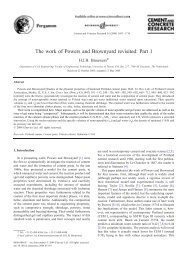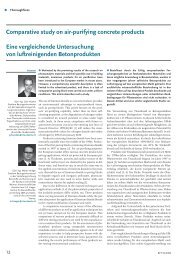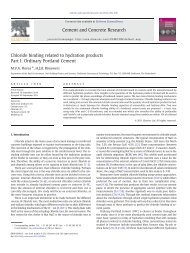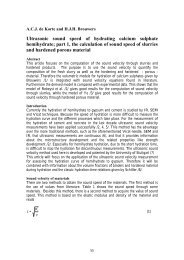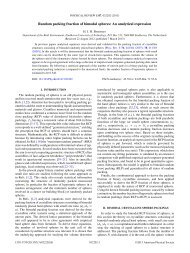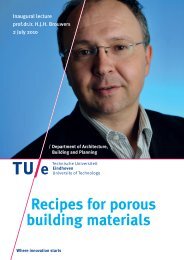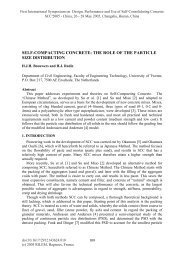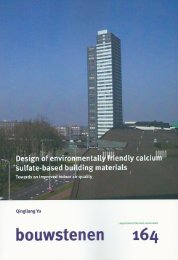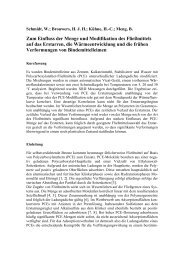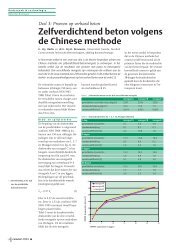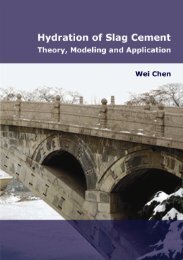RCM: A new model accounting for the non-linear ... - Jos Brouwers
RCM: A new model accounting for the non-linear ... - Jos Brouwers
RCM: A new model accounting for the non-linear ... - Jos Brouwers
You also want an ePaper? Increase the reach of your titles
YUMPU automatically turns print PDFs into web optimized ePapers that Google loves.
298 P. Spiesz et al. / Construction and Building Materials 27 (2012) 293–304<br />
Additionally, one can assume that <strong>the</strong>re will be instantaneous<br />
equilibrium between <strong>the</strong> concentration of chlorides bound in <strong>the</strong><br />
solid (cement paste) and <strong>the</strong> chlorides in <strong>the</strong> liquid–solid interface.<br />
Thus, such conditions can be described as <strong>non</strong>-equilibrium between<br />
<strong>the</strong> concentrations of chlorides in <strong>the</strong> bulk solution and<br />
bound-chlorides due to <strong>the</strong> liquid–solid mass transfer resistance.<br />
From literature it is known that <strong>the</strong> equilibrium <strong>for</strong> chloride<br />
binding experiments in concrete can be achieved after 7 days [1]<br />
or 10–14 days [23] of exposure. For <strong>the</strong> diffusion tests, <strong>the</strong> assumption<br />
of equilibrium is acceptable since <strong>the</strong> chloride exposure period<br />
is sufficiently long. However, <strong>the</strong> duration of <strong>the</strong> <strong>RCM</strong> test usually<br />
amounts to 24 h and rarely varies from 6 h (<strong>for</strong> poor quality concrete)<br />
up to 4 days (<strong>for</strong> very good quality concrete). This fact is also<br />
pointed out in [14]. There<strong>for</strong>e, during <strong>the</strong> migration process, equilibrium<br />
between free- and bound-chlorides concentrations cannot<br />
be achieved, which implies a necessity of <strong>the</strong> application of <strong>the</strong> Cl<br />
mass transfer rate. The mass transfer rate of chlorides from <strong>the</strong><br />
pore solution, through <strong>the</strong> liquid–solid interface and towards <strong>the</strong><br />
solid, is considered to be induced by a concentration gradient in<br />
<strong>the</strong>se phases.<br />
It is worth to mention that <strong>the</strong> D app obtained from diffusion<br />
tests (e.g. NT Build 443 [24]) and <strong>non</strong>-steady-state migration tests<br />
(NT Build 492 [2]) cannot be equal to each o<strong>the</strong>r because <strong>the</strong><br />
assumption of equilibrium in <strong>the</strong>ir <strong>the</strong>oretical <strong>model</strong>s is fulfilled<br />
<strong>for</strong> <strong>the</strong> diffusion tests, but is not valid <strong>for</strong> <strong>the</strong> <strong>RCM</strong> test.<br />
4. Non-<strong>linear</strong> chloride binding and <strong>non</strong>-equilibrium conditions<br />
during migration<br />
Sometimes researchers state that <strong>the</strong> interaction between chloride<br />
ions and concrete matrix can be ignored, since <strong>the</strong> application<br />
of an electrical field generates an ionic transport rate which is<br />
much faster than <strong>the</strong> kinetics of chemical reactions in concrete or<br />
that <strong>the</strong> exposure time to chloride solution during <strong>the</strong> <strong>RCM</strong> test<br />
is too short. In order to verify this statement, <strong>the</strong> presence of chloride<br />
binding during <strong>the</strong> <strong>RCM</strong> experiments is investigated in this<br />
Section by analyzing some literature data concerning <strong>the</strong> total<br />
chloride concentration profiles in concrete after <strong>the</strong> <strong>RCM</strong> test.<br />
The measurements of chloride concentration profiles are conducted<br />
by flushing concrete dust (from dry-grounded layers of<br />
<strong>the</strong> material) in nitric acid in order to extract <strong>the</strong> chloride ions.<br />
Then <strong>the</strong> concentration of <strong>the</strong> extracted chlorides is measured by<br />
using a chloride-selective electrode or titration method. The measured<br />
value represents <strong>the</strong> total chloride concentration in <strong>the</strong> concrete<br />
sample (Ct), thus consists of both: free- (c) and boundchlorides<br />
(Cb):<br />
Ct ¼ uc þð1 uÞqsCb ; ð13Þ<br />
qc where u is <strong>the</strong> water accessible porosity of concrete, qs <strong>the</strong> density<br />
of solid state of concrete and q c is <strong>the</strong> density of saturated concrete.<br />
If <strong>the</strong>re would be no chloride binding in concrete, Eq. (13) can<br />
be simplified to:<br />
Ct ¼ uc<br />
: ð14Þ<br />
qc During <strong>the</strong> migration process, <strong>the</strong> concentration of chlorides in<br />
<strong>the</strong> pore solution of concrete tends in time to <strong>the</strong> concentration in<br />
<strong>the</strong> bulk solution (c ? c 0 = 70.9 g/dm 3 ). Considering <strong>the</strong> absence of<br />
chloride binding in concrete during <strong>the</strong> migration test, <strong>the</strong><br />
maximum chloride concentration <strong>for</strong> <strong>the</strong> concrete tested by Stanish<br />
[12] (Table 1, concrete C2) amounts to 0.397% ðg Cl =g concreteÞ,<br />
as can be computed from Eq. (14). Never<strong>the</strong>less, as shown in<br />
Fig. 4, <strong>the</strong> measured maximum concentration, about 0.85%<br />
ðg Cl =g concreteÞ, exceeds this value substantially. This effect cannot<br />
Fig. 4. Measured chloride concentration profiles [12] vs. <strong>the</strong>oretical maximum<br />
values.<br />
be explained by a higher porosity than <strong>the</strong> one which was measured<br />
– <strong>for</strong> <strong>the</strong> Cl concentration equal to 0.85% ðg Cl =g concreteÞ <strong>the</strong><br />
water accessible porosity u should exceed 26%, which is an unrealistic<br />
value <strong>for</strong> a conventional concrete. Thus, <strong>the</strong> high total concentration<br />
of chlorides confirms <strong>the</strong> presence of chloride binding.<br />
In order to analyze <strong>the</strong> presence of equilibrium between freeand<br />
bound-chlorides in concrete in <strong>the</strong> case when c 0 concentration<br />
is reached in <strong>the</strong> pore solution (see Fig. 2), <strong>the</strong> maximum boundchloride<br />
concentration (C b) is calculated from Eq. (12) <strong>for</strong><br />
Kb = 0.6 10 3 (dm 3n /g n ) and n = 0.51 (Kb and n extrapolated from<br />
Table 2 <strong>for</strong> concrete), and amounts to 0.0053 ðg Cl =g solidÞ. This maximum<br />
bound-chloride concentration contributes 0.46% to <strong>the</strong> Ct,<br />
applying q s = 2606 g/dm 3 (Table 1). There<strong>for</strong>e, <strong>the</strong> maximum value<br />
of <strong>the</strong> total chloride concentration in concrete (Eq. (13)) implying<br />
equilibrium according to <strong>the</strong> <strong>non</strong>-<strong>linear</strong> binding iso<strong>the</strong>rm (Eq.<br />
(12)), when <strong>the</strong> c0 is reached in <strong>the</strong> pore solution, would yield<br />
0.86% ðg Cl =g solidÞ, as appears in Fig. 4.<br />
In <strong>the</strong> <strong>the</strong>oretical profile shown in Fig. 2 <strong>the</strong> maximum concentration<br />
of chlorides is reached in deeper layers of concrete<br />
too, while in <strong>the</strong> experimental chloride concentration profiles in<br />
Fig. 4 <strong>the</strong> concentration of chlorides decreases gradually along<br />
<strong>the</strong>ir whole length. Also in all <strong>the</strong> o<strong>the</strong>r experimental chloride<br />
profiles presented in [1,8,9,12–16], <strong>the</strong> maximum C t is reached<br />
only at <strong>the</strong> surface of concrete. A possible explanation of this phenome<strong>non</strong><br />
can be <strong>the</strong> absence of equilibrium between free- and<br />
bound-chlorides, because if <strong>the</strong> free-chlorides are not bound<br />
instantaneously <strong>the</strong>y have freedom to penetrate far<strong>the</strong>r into <strong>the</strong><br />
concrete.<br />
5. New chloride transport <strong>model</strong> <strong>for</strong> <strong>the</strong> <strong>non</strong>-steady-state<br />
migration<br />
The main idea of <strong>the</strong> <strong>new</strong> <strong>model</strong> proposed in this paper is an<br />
introduction of <strong>the</strong> <strong>non</strong>-<strong>linear</strong> chloride binding iso<strong>the</strong>rm and<br />
<strong>non</strong>-equilibrium between free- and bound-chlorides concentrations,<br />
in <strong>the</strong> system based on <strong>the</strong> Nernst–Planck equation.<br />
5.1. Governing equations<br />
The simplified Nernst–Planck equation (Eq. (3)) is commonly<br />
used to describe ionic transport in porous medium due to combined<br />
actions of migration and diffusion. However, as showed in<br />
Fig. 5 [25], when a sufficiently large electrical field is applied across



